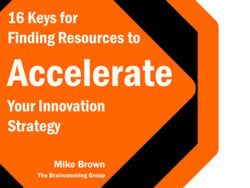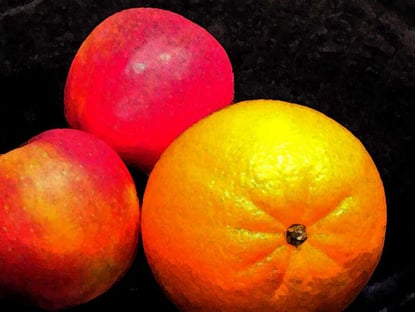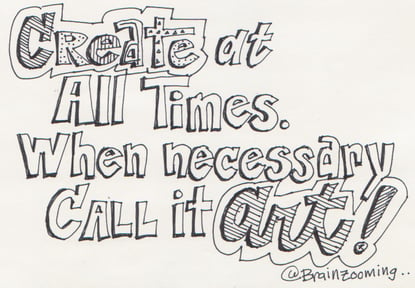At a recent Brainzooming client creative thinking session, the company’s Chief Operating Officer told a story about seeing a car with both an anti-corporation bumper sticker and an Apple logo on it. His point was how interesting it is that Apple had transcended being a huge, very profitable corporation by the car owner.
His story made me blurt out, “Did you hear about the Harvard Business Review journalist who wrote a very thorough comparison between the innovation styles of Steve Jobs and the management team at Sunkist?
“He was widely criticized for comparing Apple and oranges!”
Feel free to insert your guffaws here! When we get brains zooming (even our own), who knows what types of connections will be made?
Comparing Apples and Oranges
“Comparing apples and oranges” ranks with “think outside the box” as one of my least favorite business jargon phrases. “Comparing apples and oranges” is typically used by a strategic dolt to shut down creative thinking and obscure connections that may very naturally exist between two or more things.
Apples and oranges actually have MANY things in common. Even though they aren’t identical on the surface, there are multiple strategic and creative comparisons to be made about their similarities and differences.
In fact, considering ways of comparing apples and oranges can help your creative thinking skills. Next time a strategic dolt tries to get in the way of your creative thinking by saying you’re comparing apples and oranges, remember these ways the two fruits (or anything you're examining that may seem unrelated) can be compared:
1. Apples and oranges move through comparable PROCESSES
The supply chain bringing apples and oranges together at a grocery store or fruit stand for sale is obviously a point of comparison. When you’re comparing potentially disparate things, look for comparable processes they each experience.
2. Apples and oranges are SUBSTITUTES for one another
Since both apples and oranges satisfy the need for food, in general, and fruit, specifically, they serve as potential SUBSTITUTES for one another. As you look at potentially dissimilar items, consider how they might meet the same or related needs.
3. Apples and oranges can be made MORE SIMILAR
You can manipulate apples and oranges for greater similarity (i.e., by cutting them into similarly-sized pieces, or putting them into recipes as ingredients). When making a comparison others think is a stretch, transform the two things to accentuate their similarities strategically, numerically, chronologically, or in other ways.
4. Compare the REASONS FOR DIFFERENCES between apples and oranges
You can explore the reasons apples and oranges are or are not appropriate for comparison and make comparisons about that! Similarly, when comparing two things others think don’t match up, dive into why they appear to be different, whether because of strategic direction, motivation, nature/nurture, etc.
5. Acknowledge the differences and COMPARE THEM ANYWAY
Maybe apples and oranges are all you have to analyze. In that case, to better understand them, comparing and contrasting the differences is your only option. Being able to compare things to provide context and contrast is vital to analysis. When others lack the creative thinking skills to see the similarities in two things you’re analyzing, turn it around and simply compare differences.
6. Make a FANCIFUL COMPARISON between apples and oranges
Many strategic business conversations have an air of seriousness and a resistance to anything not grounded in reality. Don’t let that stop you. If people shut down more realistic comparisons as inappropriate, get crazy on them with a really outlandish comparison. The conversation you’ll stimulate will likely yield the greatest creative value.
7. Even if apples and orange were completely unrelated, RANDOM ITEMS trigger creative ideas
Pick any two things that really ARE completely unrelated. Looking for the comparisons and contrasts between them will get peoples’ minds working on new paths, sparking creative ideas. What will those creative ideas be? It’s tough (maybe impossible) to imagine in advance what a particular group will come up with creatively when considering random inputs, but be prepared for dramatically new thinking
Seven Apples and Oranges Comparisons for Creative Thinking
There you have it. Seven ways to consider comparing apples and oranges (or other things perceived to be dissimilar) to counter a strategic dolt trying to squash creative thinking. Simply remember you can push a strategic comparison based on:
- Process similarities
- A potential substitute realtionship
- Changes to accentuate similarities
- The reasons for underlying differences
- Comparing elements that shouldn’t be compared
- Fanciful similarities
- Completely random connections
So when was the last time YOU were accused of comparing apples and oranges? I'll bet now you can't wait for the next time it happens! – Mike Brown
If you enjoyed this article, subscribe to the free Brainzooming blog email updates.
Discover New Resources to Innovate!
NEW FREE Download: 16 Keys for Finding Resources to Accelerate Your Innovation Strategy
 You know it’s important for your organization to innovate. One challenge, however, is finding and dedicating the resources necessary to develop an innovation strategy and begin innovating.
You know it’s important for your organization to innovate. One challenge, however, is finding and dedicating the resources necessary to develop an innovation strategy and begin innovating.
This Brainzooming eBook will help identify additional possibilities for people, funding, and resources to jump start your innovation strategy. You can employ the strategic thinking exercises in Accelerate to:
- Facilitate a collaborative approach to identifying innovation resources
- Identify alternative internal strategies to secure support
- Reach out to external partners with shared interests in innovation
Download your FREE copy of Accelerate Your Innovation Strategy today! 




